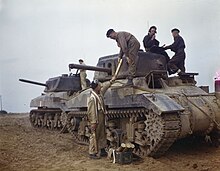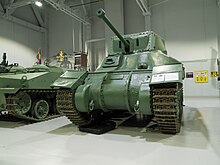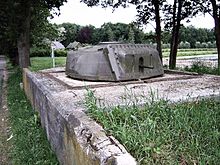Ram tank
| Tank, Cruiser, Ram | |
|---|---|
Continental R-975 9-cyl radial gasoline engine400 (298 kW) | |
| Power/weight | 12.3 hp/ton |
| Transmission | Borg-Warner clutch, controlled differential |
| Suspension | Vertical volute spring |
Operational range | 232 km (144 mi) |
| Maximum speed | 25 mph (40 km/h) |
The Tank, Cruiser, Ram was a
Development

Even before the loss of the majority of the United Kingdom's tank force in France in 1940 after Dunkirk, it was recognised that tank production in the UK at the start of the war was insufficient and capacity in the US was taken for British needs.[2] So it was necessary that if Canada was to equip with tanks they would have to be manufactured locally.[3] In June 1940 the Canadian Pacific Railway's Angus Shops in Montreal, as the only large firm with spare capacity, had received a contract to produce 300 partially fitted out Valentine tanks for the British; this was followed later with one for 488 complete tanks for Canada.[4] However the Valentine was an infantry tank and Canada required a cruiser tank for its recently formed armoured division. In the end 1,420 Valentines were produced by CPR, most of which were supplied to the USSR. Although the Valentine used a number of American produced parts, its reliance on British components, difficulties in adapting its manufacture to North American methods, and other problems such as limitations to the availability of the right type of armour plate affected Valentine production. The Canadian Joint Committee on Tank Development concluded, in September 1940, that its cruiser tank should be based on a US rather than a British design.[5] This would be quicker and allow it to use components already in production for the US design.[6]
The Canadians were interested in production of the
The new hull was cast rather than welded or riveted and lower than that of the M3. The pilot model's turret and upper hull casting was produced in the US by General Steel Castings and later they aided the set up of Canadian production.[3] Montreal Locomotive Works (MLW) was chosen to make the new Canadian M.3 Cruiser Tank (as it was then known) and was given the funding to set up the Canadian Tank Arsenal at Longue Pointe. MLW was a subsidiary of the American Locomotive Company, which had experience in producing large castings and Alco was producing cast hulls for the M3 Medium.
Canadian engineers ran into many challenges when developing the tank as Canada had never produced a tank before. Along with the lack of knowledge, it took time for Canadian factories to gear up for the production of many of the Ram's components.
Initially Canada relied heavily on United States and British materials to complete the construction of the Ram. Most critically the Ram's Continental engine and transmissions were available only in the USA and these were always in short supply. The Ram tank was developed with a turret which unlike the US M3 could traverse the main armament 360 degrees. Its fully cast armoured steel hull gave reinforced protection and, with the driver's seat repositioned to meet British requirements for right-hand drive,[3] lower height; while the U.S.-designed chassis and power train ensured its overall reliability.[9]
Although it could mount a

A prototype Ram was completed in June 1941 and general production of the Ram I began in November of the same year. The Ram I and early Ram IIs were fitted with side doors in the hull and an auxiliary machine gun turret in the front. The former weakened the hull and complicated production, and the doors and the machine gun turret were discarded in later modifications. By February 1942 production had switched to the Ram II model with a 6-pounder gun and continued until July 1943. In March 1942 a decision had been made to change production over to the automotively-similar M4A1
The official Canadian history of the war compares the Ram to the Ross rifle as examples of unsuccessful Canadian weapon designs. It states that given the Sherman's superiority, in retrospect it would probably have been better for the United States to produce more tanks, and for Canada to have focused on manufacturing more transport vehicles such as the successful Canadian Military Pattern truck designs. The Sexton self-propelled gun based on the Ram chassis, however, was very successful.[11]
Combat history

As built, the Ram was never used in combat as a tank, but was used for crew training in Canada and Great Britain up to mid 1944. The

In 1945 the
Survivors
One Dutch Ram tank, an OP/Command vehicle, survives at the Dutch Cavalry Museum in Amersfoort.
A Ram tank modified as a Kangaroo serves as a memorial to the 1st Canadian Armoured Carrier Regiment in Mill, Netherlands.
Ram tanks can also be seen at the
)A Ram Tank can also be seen outside of the Armoured Trial and Development Unit based at Bovington Camp.
Variants
- Tank Cruiser, Ram Mk I
- Ordnance QF 2 pounder/ 40mm gun (171 rounds).
- Tank Cruiser, Ram Mk II
- Early production: Mk III QF 6 pounder(57 mm) gun with 92 rounds.
- Late production: Mk V six-pounder. Auxiliary turret and sponson door removed. Browning .303 in (7.7 mm) machine gun fitted in ball mount.
- Badger
- A Wasp II flamethrowing equipment (as used on the Universal Carrier) installed in place of the bow MG. Later models were turreted Rams with the equipment in place of the main gun.
- Ram Kangaroo
- Ram with turret removed to give an armoured personnel carrier capable of carrying 11 battle-ready troops (or -- more often -- as many as could fit) as well as the two crew. See Kangaroo.
- Ram OP/Command (84)
- An armoured vehicle to function as a mobile observation posts for the Forward Observation Officers (FOO) of Sexton self-propelled gun units, based on Ram Mk II. The gun was replaced by a dummy, and two Wireless Set No. 19 radios were fitted with a No. 58 set. Crew of six. They were built from the last 84 Rams off the production line in 1943.[3]
- Ram GPO
- Like OP but with special equipment for "Gun Position Officers" of self-propelled artillery regiments. Had Tannoy loudspeakers mounted.
- Sexton "25-pdr, SP, Tracked"
- QF 25 poundergun in open-topped superstructure.
- Ram Ammunition Carrier
- Also called "Wallaby", an armoured ammunition supply vehicle, converted as for the Kangaroo but used to carried 25-pdr ammunition for Sexton.
- Ram ARV Mk I
- Armoured recovery vehicle created by adding winch gear added to Ram Mark I .
- Ram ARV Mk II
- Armoured Recovery Vehicle based on Ram Mk II. Jibs and earth spade added, turret replaced by dummy.
- Ram Gun Tower
- Ordnance QF 17 pounder towed Anti-tank gun.
In addition, a Ram was used in an attempt to produce a
-
Ram Mk I
-
Ram Mk II – early production
-
Ram Mk II – later production, with Mk III QF 6 pounder but still with auxiliary turret
-
Ram OP/Command tank at Amersfoort
-
Ram Kangaroo at The Tank Museum, Bovington
-
Sexton I
-
Ram 3.7 inch during testing
See also
Tanks of comparable role, performance, and era
- Australian Sentinel
- British Cromwell
- German Panzer IV
- Hungarian Turán III
- Italian Carro Armato P 40
- Italian P43(proposal)
- Japanese Type 3 Chi-Nu
- Romanian 1942 medium tank (proposal)
- Soviet T-34
- Swedish Stridsvagn m/42
- American M4 Sherman
- Argentinian Nahuel DL 43
Other Commonwealth Tanks of the Second World War
- Bob Semple tank – New Zealand indigenous tank design
- Grizzly tank– Canadian licence built M4A1 Sherman
- Schofield tank – New Zealand indigenous tank design
- Sentinel tank - Australian indigenous tank design
Notes
- Presidio Press. pp. 535–536.
- ^ Ellis and Chamberlain p3
- ^ a b c d e Ellis and Chamberlain
- ^ Ellis & Chamberlain p5
- ^ Cameron, L.R.Tank Production in Canada AHQ Report 38, Department of National Defence Directorate of History and Heritage (DHH), 27 July 1950
- ^ Chamberlain & Ellis (1969) p172
- ^ Ellis and Chamberlain p6
- ^ a b Fletcher, Great Tank Scandal, p. 94.
- ^ Broad p27
- ^ Chamberlain and Ellis p172
- ^ Stacey, C. P. (1970). Arms, Men and Government: The War Policies of Canada, 1939–1945 (PDF). The Queen's Printer by authority of the Minister of National Defence. pp. 513–514.
- ^ Ellis and Chamberlain p18
- ^ Tank Cruiser, Ram Mark II (E1988.23), Tank Museum
- ^ Ram Kangaroo, Armoured Personnel Carrier, Full Tracked (E1985.121), Tank Museum
- ^ Chamberlain & Ellis (1969) p 174
References
- Chris Ellis, Peter Chamberlain – AFV No. 13 – Ram and Sexton, Profile Publications, England
- Chamberlain, Peter; Ellis, Chris (1969), British and American Tanks of World War II (2nd US (1981) ed.), Arco Publishing
- Roberts, Paul – The Ram – Developments and Variants, Vol. 1, Service Publications, Ottawa, Canada 2002
- Roberts, Paul – The Ram – Developments and Variants, Vol. 2, Service Publications, Ottawa, Canada 2004
- Law, Clive – Making Tracks – Tank Production in Canada, Service Publications, Ottawa, Canada 2001
- ISBN 978-0-11-290460-1.
- Broad, Graham – "Not competent to produce tanks" The Ram and Tank Production in Canada, 1939-1945, Canadian Military History Volume 11 Number 1, Beacon Herald Fine Printing Division, Stratford, Canada 2002
- Wallace, John F. – Dragons of Steel: Canadian Armour in Two World Wars, The General Store Publishing House, Burnstown, Canada 1995
External links
- Newsreel of Ram tanks in production and testing. Archived 11 June 2011 at the Wayback Machine
- WWII vehicles
- Mapleleafup.org
- Ram Tank registry
- Dutch Cavalry Museum has a RAM Tank Mk.2 in its collection.







